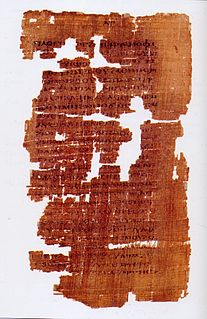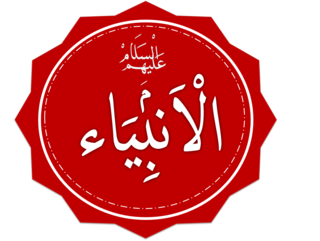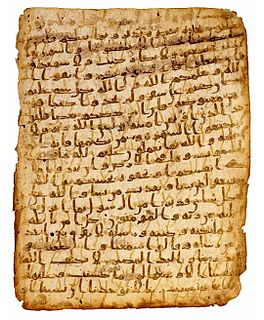
The Quran is the central religious text of Islam, believed by Muslims to be a revelation from God (Allah). It is widely regarded as the finest work in classical Arabic literature. It is organized in 114 chapters, which consist of verses.

The Vatican Apostolic Library, more commonly known as the Vatican Library or informally as the Vat, is the library of the Holy See, located in Vatican City. Formally established in 1475, although it is much older—it is one of the oldest libraries in the world and contains one of the most significant collections of historical texts. It has 75,000 codices from throughout history, as well as 1.1 million printed books, which include some 8,500 incunabula.
Arabic literature is the writing, both as prose and poetry, produced by writers in the Arabic language. The Arabic word used for literature is Adab, which is derived from a meaning of etiquette, and which implies politeness, culture and enrichment.

The Syriac Infancy Gospel, also known as the Arabic Infancy Gospel, is a New Testament apocryphal writing concerning the infancy of Jesus. It may have been compiled as early as the sixth century, and was partly based on the Infancy Gospel of Thomas, and Protevangelium of James. There are only two surviving manuscripts dating from 1299 AD and the 15th/16th century in Arabic. They were copied in the area of northern Iraq and show influence from the Quran.
George Sale (1697–1736) was a British Orientalist scholar and practising solicitor, best known for his 1734 translation of the Quran into English. In 1748, after having read Sale's translation, Voltaire wrote his own essay "De l'Alcoran et de Mahomet". Voltaire shared Sale's view that Mohammed was a "sublime charlatan" Voltaire bestowed high praise on Sale but misasserted him to have spent twenty-five years in Arabia.

Maghrebiscript refers to a loosely related family of Arabic scripts that developed in the Maghreb, al-Andalus (Iberia), and Biled as-Sudan. Maghrebi script is influenced by Kufic letters, and is traditionally written with a pointed tip, producing a line of even thickness.
Usulis are the orthodox majority Twelver Shi'a Muslim group. They differ from their much smaller rival Akhbari group in favoring the use of ijtihad in the creation of new rules of fiqh; in assessing hadith to exclude traditions they believe unreliable; and in considering it obligatory to obey a mujtahid when seeking to determine Islamically correct behavior.

Beit Al Qur'an is a multi-purpose complex dedicated to the Islamic arts and is located in Hoora, Bahrain. Established in 1990, the complex is most famous for its Islamic museum, which has been acknowledged as being one of the most renowned Islamic museums in the world.

The Tusi couple is a mathematical device in which a small circle rotates inside a larger circle twice the diameter of the smaller circle. Rotations of the circles cause a point on the circumference of the smaller circle to oscillate back and forth in linear motion along a diameter of the larger circle. The Tusi couple is a 2-cusped hypocycloid.

The Qiṣaṣ al-'Anbiyā' or Stories of the Prophets is any of various collections of stories adapted from the Quran and other Islamic literature, closely related to exegesis of the Qur'an. One of the best-known is a work composed by the Persian author Abū Ishāq Ibrāhīm bin Mansūr bin Khalaf of Neyshābūr the 12th century AD ; another was composed by Muhammad al-Kisai in the 8th century AD ; others include the Ara'is al-Majalis by al-Tha'labi and the Qasas al-Anbiya by Ibn Kathir. The narrations within the Qisas Al-Anbiya, are not about historical accuracy, but rather about wisdom and moral teachings.

'Aja'ib al-Makhluqat wa Ghara'ib al-Mawjudat, is a book in Arabic and an important work of cosmography by Zakariya al-Qazwini, who was born in Qazwin in the year 600 AH/1203 AD.

Hadith Bayāḍ wa Riyāḍ is a 13th-century Arabic love story. The main characters of the tale: Bayad, a merchant's son and a foreigner from Damascus, Riyad, a well-educated slave girl in the court of an unnamed Hajib of 'Iraq (Mesopotamia), and a "Lady" (al-sayyida).

al-masad (Arabic: ألْمَسَدْ, is the 111th chapter of the Quran with 5 verses.

The Kitāb al-Fihrist is a compendium of the knowledge and literature of tenth-century Islam compiled by Ibn Al-Nadim. It references approx. 10,000 books and 2,000 authors. This crucial source of medieval Arabic-Islamic literature, informed by various ancient Hellenic and Roman civilizations, preserves from his own hand the names of authors, books and accounts otherwise entirely lost. Al-Fihrist is evidence of Al-Nadim's thirst for knowledge among the exciting sophisticated milieu of Baghdad's intellectual elite. As a record of civilisation transmitted through Muslim culture to the West world, it provides unique classical material and links to other civilisations.

Muhammad ibn Muhammad ibn al-Hasan al-Tūsī, better known as Nasir al-Din al-Tusi, was a Persian polymath, architect, philosopher, physician, scientist, and theologian. Nasir al-Din al-Tusi was a well published author, writing on subjects of math, engineering, prose, and mysticism. Additionally, al-Tusi made several scientific advancements. In astronomy, al-Tusi created very accurate tables of planetary motion, an updated planetary model, and critiques of Ptolemaic astronomy. He also made strides in logic, mathematics but especially trigonometry, biology, and chemistry. Nasir al-Din al-Tusi left behind a great legacy as well. Some consider Tusi one of the greatest scientists of medieval Islam, since he is often considered the creator of trigonometry as a mathematical discipline in its own right. The Muslim scholar Ibn Khaldun (1332–1406) considered Tusi to be the greatest of the later Persian scholars. There is also reason to believe that he may have influenced Copernican heliocentrism.

The codex Parisino-petropolitanus is one of the very oldest extant manuscripts of the Quran, attributed to the 7th century.

The Birmingham Quran manuscript is a parchment on which two leaves of an early Quranic manuscript are written. In 2015 the manuscript, which is held by the University of Birmingham, was radiocarbon dated to between 568 and 645 CE. It is part of the Mingana Collection of Middle Eastern manuscripts, held by the university's Cadbury Research Library.

In Muslim tradition the Quran is a final revelation from God, Islam’s divine text, delivered to the Islamic prophet Muhammad through the angel Jibril (Gabriel). Muhammad’s revelations were said to have been recorded orally and in writing, through Muhammad and his followers up until his death in 632 CE. These revelations were then compiled by first caliph Abu Bakr and codified during the reign of the third caliph Uthman so that the standard codex edition of the Quran or Muṣḥaf was completed around 650 CE, according to Muslim scholars. However, some Western scholars have questioned this, suggesting the Quran was canonized at a later date, based on the fact that the classical Islamic narratives were written generations—150 to 200 years—after the death of Muhammad, and on variants from the standard Quran found in early manuscripts and fragments.
Eliya ibn ʿUbaid, also called Īlīyā al-Jawharī, was a theologian, philosopher, canonist and chronographer of the Church of the East. He served as the bishop of Jerusalem from 878 or 879 until 893 and then as the archbishop of Damascus. He wrote in Arabic. He died after 903.